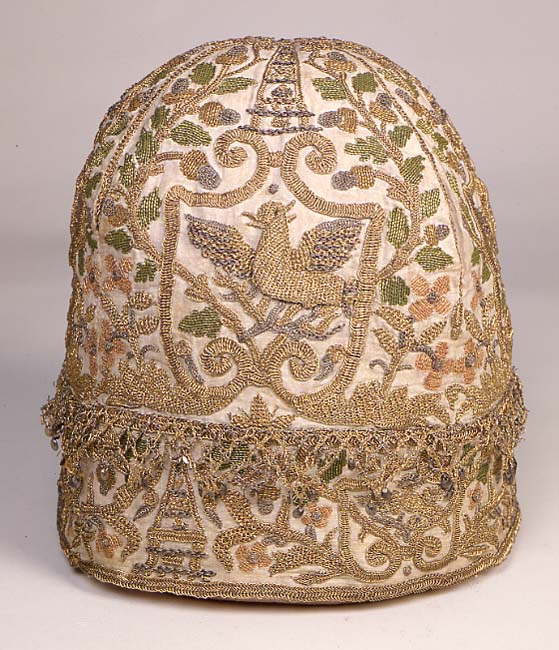cap & nightcap
Summary
White linen, embroidered mainly in silver and silver gilt thread, with pink, green and gold silk thread in a variety of looped chain and interlaced stitches and couchings. Design of phoenix with flames of gold and silver enclosed in scrolls forming shield shape from base of two stems which extend outside it to top of cap, with oak leaves, green and silver gilt, and acorns silver and silver gilt and gold silk, floral; sprays, flowers pink and silver gilt from base of shield and outside it, obelisk/pyramid shape with cresent above, at top; body of phoenix worked in separate fabric from ground: design repeated on smaller scale on border, obelisk between sprays, alternating with phoenix, row of double chain stitch at top of borderedge of cap. Linen in one piece with one seam curving to crown sewn after embroidering ; top cut in four triangular sections seamed to shape beneath row of double chain stitch, design repeated for each section, embroidered band (6cm) at base, with spangled silver and silver-gilt bobbin lace sewn on at top: pink silk ( pink warp, white weft) lining seamed as cap, darted and slightly gathered to circular crown section, sewn to cap at lower edge; linen lining between shaped as cap, sewn on at lower edge and caught at crown. From the Seton family in Berwickshire (passed to the Hays family of Duns Castle after the sale at Seton Castle in 1706)
Display Label
Nightcaps were worn by men from the sixteenth to the eighteenth centuries, not simply for night attire, but for informal, domestic day and evening wear, specifically after the 1660s, to cover the head after removing the wig. Usually made of linen, and often lavishly embroidered with coloured silks and metal threads, they were made as close-fitting dome-shaped caps in the seventeenth century. In the eighteenth century they became looser, more like a turban, and were frequently worn with the nightgown or banyan, again, not for bed but for informal relaxing about the house, or even for entertaining family and friends. The yellow nightcap in the main image dates from around 1700, and is entirely covered with floral embroidery on a split-stitch yellow silk ground, with blue silk ties and trim. The black and white print below shows an eighteenth century man sitting at ease in a similar cap, having taken off his heavy hot wig. The other embroidered cap below is more dome-shaped and dates from the early seventeenth century. It is highly decorated with silk and silver thread embroidery and stitched with popular classical motifs like the phoenix and the obelisk surrounded by a scrolling leaf and flower design. Blackwork caps were also common, as were white linen ones, quilted for warmth, or trimmed with expensive bobbin or needlelaces.
Object Name
cap & nightcap
Date Created
1600-1625
Dimensions
Height: 20cm
accession number
1971.50
Place of creation
England
Medium
Legal
© Manchester Art Gallery

